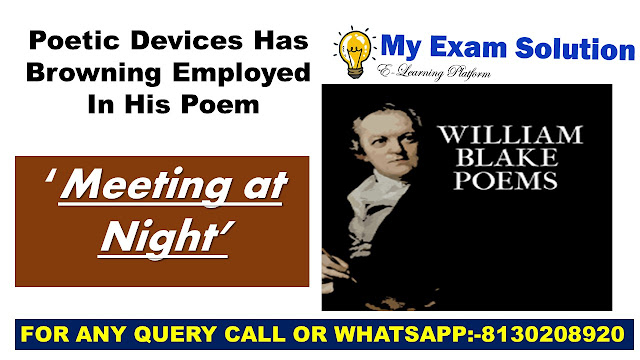What poetic devices has Browning employed in his poem ‘Meeting at Night’
Meeting at Night" is a poem by Victorian poet Robert
Browning, which follows the journey of its speaker to a meeting with a lover.
It was published in Dramatic Romances and Lyrics (1845) with an
additional "Morning" section (that section was later separated into a
different poem titled "Parting at Morning"). Browning composed the
poem during his courtship of Elizabeth Barrett, his future wife, who was already
a successful poet at the time. Barrett's father did not approve of Browning,
and perhaps a hint of this can be detected in the hushed and secretive nature
of the "meeting." The poem is unusual for the Victorian era because
it is so sensual and sexually suggestive in a time of moral and social
conservatism.
Robert Browning, (born May 7, 1812, London—died Dec. 12, 1889, Venice), major English poet of the Victorian age, noted for his mastery of dramatic monologue and psychological portraiture. His most noted work was The Ring and the Book (1868–69), the story of a Roman murder trial in 12 books.
What poetic devices has Browning employed in his poem ‘Meeting
at Night’
“Meeting at Night” Summary
The speaker walks for a mile along the warm beach, and can
smell the sea. The speaker continues across three fields until reaching a
farm. The speaker knocks gently on a window, at which point someone else
(implied to be the speaker's lover) hurriedly strikes a match that bursts into
a blue flame. "A voice"—either the speaker's or this
lover's—talks, overcome with happiness and fear. The voice, though,
doesn't seem to be as loud as the lovers' racing hearts, which beat together.
Love and Perseverance
“Meeting at Night” aims to capture the vitality and
excitement of romantic love, especially when that love is in its early stages.
(Worth noting is that Robert Browning wrote it while courting his eventual
wife, Elizabeth Barrett, and that Barrett's father did not approve of the
match!) On a literal level, the poem tells the story of the speaker’s long and
clandestine journey through a mysterious coastal landscape. This determined
journey culminates with the speaker finally meeting up with a lover, their “two
hearts beating” powerfully together. The poem thus argues that love is precious
and worth striving for, even in the face of significant obstacles. Put simply,
love is worth the effort.
The poem takes care to detail just how hard this journey is
before revealing to the reader where the speaker is actually going. First, the
speaker traverses a “grey sea” and “long black land,” reflecting the title's
assertion that whatever "meeting" the speaker is heading towards is
taking place "at night." This further suggests that this meeting is a
secret, since it's happening under the cover of darkness when other people
aren't around to watch. This adds a sense of danger and raises the stakes of
the speaker's journey.
What poetic devices has Browning employed in his poem ‘Meeting
at Night’
The mixture of precise imagery with vague nouns like “sea”
and “land” also creates a sense of scale, suggesting the vast distance the
speaker has to travel. Indeed, even when the speaker comes ashore, the journey
isn't over. Now, the speaker must trudge down a mile of beach and cross
"three fields," again underscoring the sheer scale of this trek. The
speaker’s determination remains unwavering throughout, however, as is evident
by the fact that the speaker both keeps going and never complains about the
difficulty of this undertaking.
And again, it's important to note that it’s not until the
final line that the reader really gets a sense of why the journey is being
made. By delaying that reveal, the poem builds up a sense of anticipation—what
powerful force could be driving the speaker forward so consistently?
The answer, of course, is love: the speaker has gone on this
voyage in pursuit of romance. And when the poem finally does reveal the
speaker’s purpose, its imagery suggests the thrill of new love—symbolized here
by the match-lit meeting place and the intense intimacy of the poem’s final
line.
In a sense, now that the reader knows the whole journey has been for love, the rest of the poem comes to represent the anticipation of that love. The fact that the lovers must meet at night suggests that their love is in some way forbidden, yet that it's worth taking a risk to pursue. The lines also take on a lustful tone in hindsight: for example, the “ringlets” of water could be hair, and the final two lines of the first stanza read like a metaphor for sexual intercourse itself.
What poetic devices has Browning employed in his poem ‘Meeting
at Night’
In any case, the poem clearly suggests that love is something
vital and thrilling. Through hiding its literal meaning until the final lines,
the poem manages to capture something of the excitement—and perhaps even the
danger—of love. The speaker makes the difficult journey to meet this lover
precisely because love is worth fighting for.


.jpg)





0 comments:
Note: Only a member of this blog may post a comment.